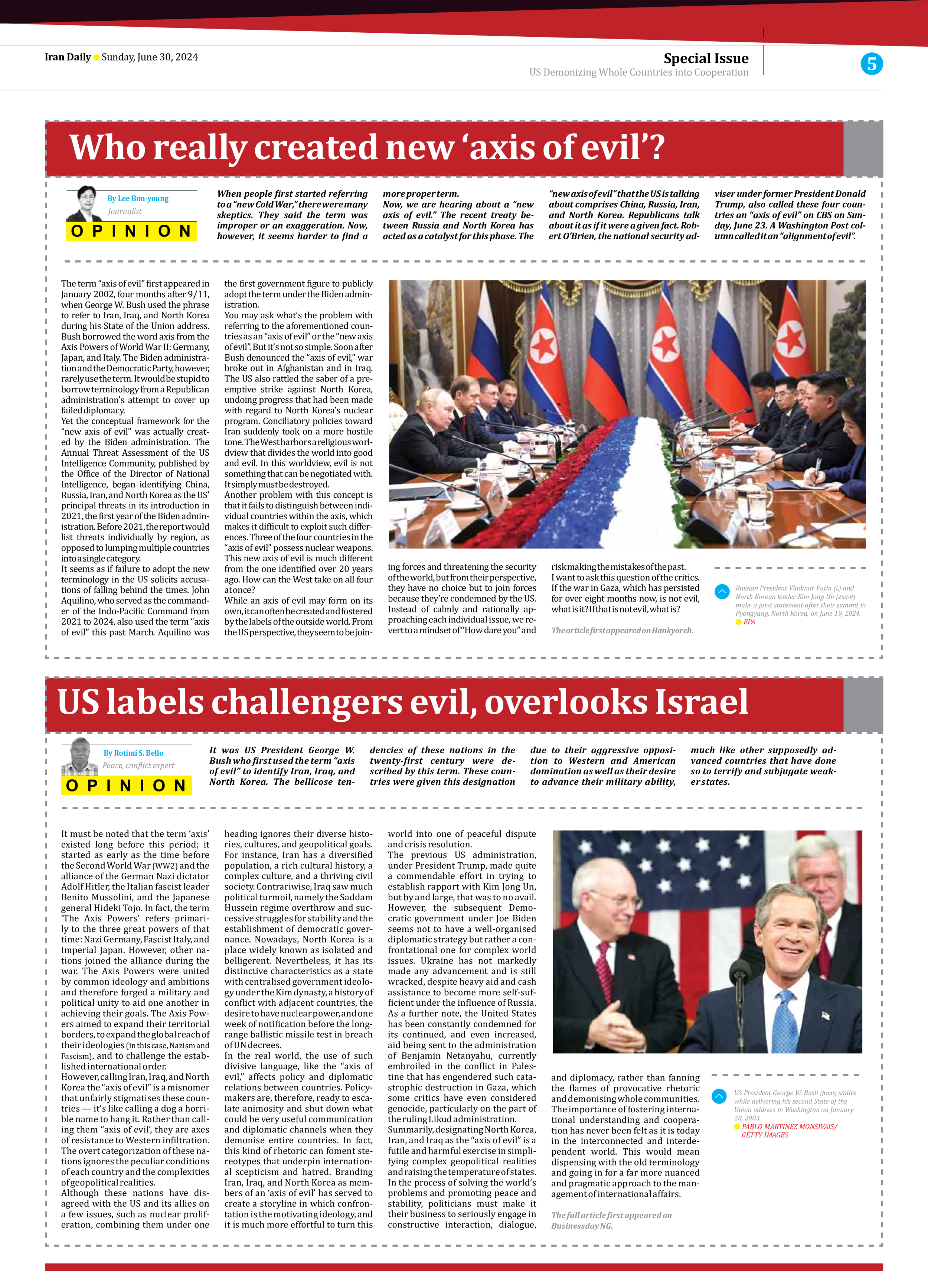
Who really created new ‘axis of evil’?
When people first started referring to a “new Cold War,” there were many skeptics. They said the term was improper or an exaggeration. Now, however, it seems harder to find a more proper term. Now, we are hearing about a “new axis of evil.” The recent treaty between Russia and North Korea has acted as a catalyst for this phase. The “new axis of evil” that the US is talking about comprises China, Russia, Iran, and North Korea. Republicans talk about it as if it were a given fact. Robert O’Brien, the national security adviser under former President Donald Trump, also called these four countries an “axis of evil” on CBS on Sunday, June 23. A Washington Post column called it an “alignment of evil”.
By Lee Bon-young
Journalist
The term “axis of evil” first appeared in January 2002, four months after 9/11, when George W. Bush used the phrase to refer to Iran, Iraq, and North Korea during his State of the Union address. Bush borrowed the word axis from the Axis Powers of World War II: Germany, Japan, and Italy. The Biden administration and the Democratic Party, however, rarely use the term. It would be stupid to borrow terminology from a Republican administration’s attempt to cover up failed diplomacy.
Yet the conceptual framework for the “new axis of evil” was actually created by the Biden administration. The Annual Threat Assessment of the US Intelligence Community, published by the Office of the Director of National Intelligence, began identifying China, Russia, Iran, and North Korea as the US’ principal threats in its introduction in 2021, the first year of the Biden administration. Before 2021, the report would list threats individually by region, as opposed to lumping multiple countries into a single category.
It seems as if failure to adopt the new terminology in the US solicits accusations of falling behind the times. John Aquilino, who served as the commander of the Indo-Pacific Command from 2021 to 2024, also used the term “axis of evil” this past March. Aquilino was the first government figure to publicly adopt the term under the Biden administration.
You may ask what’s the problem with referring to the aforementioned countries as an “axis of evil” or the “new axis of evil”. But it’s not so simple. Soon after Bush denounced the “axis of evil,” war broke out in Afghanistan and in Iraq. The US also rattled the saber of a preemptive strike against North Korea, undoing progress that had been made with regard to North Korea’s nuclear program. Conciliatory policies toward Iran suddenly took on a more hostile tone. The West harbors a religious worldview that divides the world into good and evil. In this worldview, evil is not something that can be negotiated with. It simply must be destroyed.
Another problem with this concept is that it fails to distinguish between individual countries within the axis, which makes it difficult to exploit such differences. Three of the four countries in the “axis of evil” possess nuclear weapons. This new axis of evil is much different from the one identified over 20 years ago. How can the West take on all four at once?
While an axis of evil may form on its own, it can often be created and fostered by the labels of the outside world. From the US perspective, they seem to be joining forces and threatening the security of the world, but from their perspective, they have no choice but to join forces because they’re condemned by the US. Instead of calmly and rationally approaching each individual issue, we revert to a mindset of “How dare you” and risk making the mistakes of the past.
I want to ask this question of the critics. If the war in Gaza, which has persisted for over eight months now, is not evil, what is it? If that is not evil, what is?
The article first appeared on Hankyoreh.







